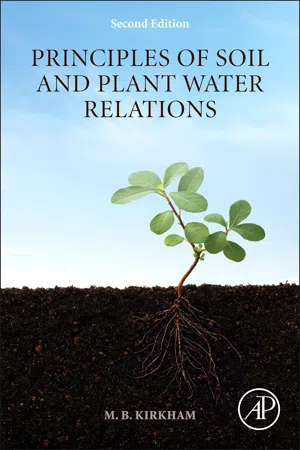
- 598 pages
- English
- ePUB (mobile friendly)
- Available on iOS & Android
Principles of Soil and Plant Water Relations
About this book
Principles of Soil and Plant Water Relations, 2e describes the principles of water relations within soils, followed by the uptake of water and its subsequent movement throughout and from the plant body. This is presented as a progressive series of physical and biological interrelations, even though each topic is treated in detail on its own. The book also describes equipment used to measure water in the soil-plant-atmosphere system. At the end of each chapter is a biography of a scientist whose principles are discussed in the chapter. In addition to new information on the concept of celestial time, this new edition also includes new chapters on methods to determine sap flow in plants dual-probe heat-pulse technique to monitor water in the root zone.- Provides the necessary understanding to address advancing problems in water availability for meeting ecological requirements at local, regional and global scales- Covers plant anatomy: an essential component to understanding soil and plant water relations
Frequently asked questions
- Essential is ideal for learners and professionals who enjoy exploring a wide range of subjects. Access the Essential Library with 800,000+ trusted titles and best-sellers across business, personal growth, and the humanities. Includes unlimited reading time and Standard Read Aloud voice.
- Complete: Perfect for advanced learners and researchers needing full, unrestricted access. Unlock 1.4M+ books across hundreds of subjects, including academic and specialized titles. The Complete Plan also includes advanced features like Premium Read Aloud and Research Assistant.
Please note we cannot support devices running on iOS 13 and Android 7 or earlier. Learn more about using the app.
Information
Introduction
Abstract
Keywords
Blackman growth curve; John Napier; Logarithms; Population curve; Sigmoid growth curve; Soil–plant–water relations1.1. Why Study Soil–Plant–Water Relations?
1.1.1. Population
Table of contents
- Cover image
- Title page
- Table of Contents
- Copyright
- Dedication
- Preface to the First Edition
- Preface to the Second Edition
- Chapter 1. Introduction
- Chapter 2. Definitions of Physical Units and the International System
- Chapter 3. Structure and Properties of Water
- Chapter 4. Soil–Water Terminology and Applications
- Chapter 5. Tensiometers
- Chapter 6. Static Water in Soil
- Chapter 7. Water Movement in Saturated Soil
- Chapter 8. Time Domain Reflectometry
- Chapter 9. Dual Thermal Probes
- Chapter 10. Field Capacity, Wilting Point, Available Water, and the Nonlimiting Water Range
- Chapter 11. Penetrometers
- Chapter 12. Oxygen Diffusion Rate
- Chapter 13. Infiltration
- Chapter 14. Pore Volume
- Chapter 15. Root Anatomy and Poiseuille's Law for Water Flow in Roots
- Chapter 16. Gardner's Equation for Water Movement to Plant Roots
- Chapter 17. Stem Anatomy and Pressure–Volume Curves
- Chapter 18. Thermocouple Psychrometers
- Chapter 19. Pressure Chambers
- Chapter 20. The Ascent of Water in Plants
- Chapter 21. Sap Flow
- Chapter 22. Electrical Analogs for Water Movement through the Soil–Plant–Atmosphere Continuum
- Chapter 23. Leaf Anatomy and Leaf Elasticity
- Chapter 24. Stomatal Anatomy and Stomatal Resistance
- Chapter 25. Solar Radiation, Black Bodies, Heat Budget, and Radiation Balance
- Chapter 26. Infrared Thermometers
- Chapter 27. Stress-Degree-Day Concept and Crop Water Stress Index
- Chapter 28. Potential Evapotranspiration
- Chapter 29. Water and Yield
- Chapter 30. Solar Time and Interception of Direct-Beam Solar Radiation
- Index